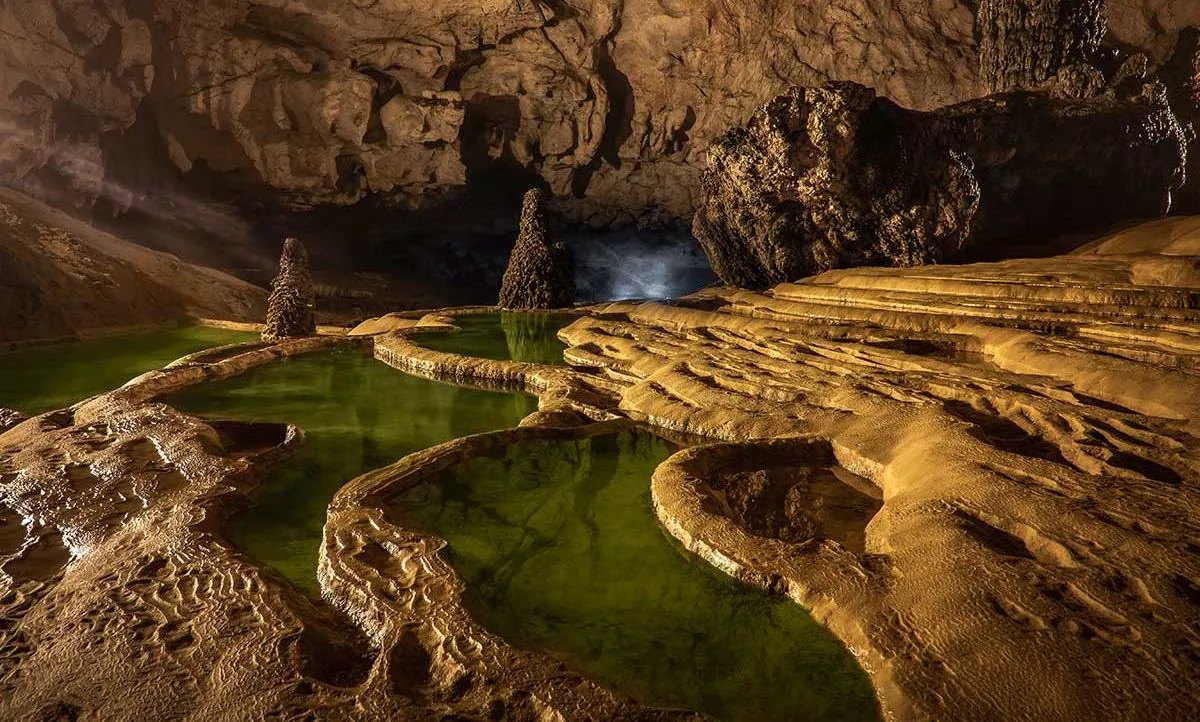
Cao Bang, in Vietnam’s far northeast, is a land of rolling hills, lush forests, and postcard-perfect scenery. While the province is famous for Ban Gioc Waterfall’s majestic cascade and the historic Pac Bo Cave, there’s another gem tucked away beneath the mountains — Nguom Ngao Cave, a surreal underground world of shimmering stalactites, vast chambers, and fascinating local legends.
📍 Where is Nguom Ngao Cave?
Nguom Ngao Cave lies in Dam Thuy Commune, Trung Khanh District, just 3 km from Ban Gioc Waterfall. Its name comes from the Tay language — “Nguom” means cave, and “Ngao” means tiger. Some say it’s because tigers once roamed here, sneaking into villages for livestock until locals set traps. Others believe the name comes from the cave’s roaring water, echoing like a tiger’s growl.
First discovered in 1921, Nguom Ngao remained largely untouched until 1996, when it officially opened to visitors. A survey by the British Royal Cave Association measured it at over 2 km long with three entrances:
- Nguom Lom – hidden at the mountain’s base
- Nguom Ngao – a short walk from the foot of the mountain
- Ban Thuon – near a Tay ethnic village behind the mountain
🌿 What Makes Nguom Ngao Special
1. A Living Gallery of Stalactites
Inside, the cave glitters with stalactites of every shape and color — icy white, golden yellow, and even mysterious blue. They’ve taken millions of years to form, shaped drop by drop by mineral-rich water. Some resemble lotus blossoms, others look like cascading waterfalls frozen in stone. Local legends add even more charm, with formations named after mythical stories.
2. Vast Chambers & Hidden Corners
Stepping into Nguom Ngao feels like entering another world. The largest chambers soar hundreds of meters wide, with towering stone pillars and natural light filtering in through cracks. In some spots, you’ll feel dwarfed by the sheer scale; in others, you’ll find cozy passages that feel like secret hideaways.
3. Cool Climate Year-Round
The cave stays refreshingly cool no matter the season, making it a perfect summer escape. The air is fresh and damp, adding to the sense of stepping into a living, breathing part of the earth.
📜 History & Cultural Significance
Beyond its beauty, Nguom Ngao holds deep meaning for the Tay and Nung ethnic groups. During wartime, locals used the cave as a refuge. It’s now part of the Non Nuoc Cao Bang UNESCO Global Geopark, recognized for both its geological value (formed over 400 million years ago) and its role in local heritage.
🛣 How to Get There
- From Hanoi: Take National Highway 3 to Cao Bang (6–8 hours), then National Highway 4A to Trung Khanh.
- By Motorbike: A favorite for adventurous travelers — the route winds through mountain passes with incredible views.
- From Cao Bang City: Only about 3 km to the cave; taxis and motorbike taxis are affordable and convenient.
💡 Travel Tips
- Best Time: October–April (dry season)
- Footwear: Sturdy shoes with good grip — cave floors can be wet
- Clothing: Bring a light jacket; it’s cooler inside
- Essentials: A flashlight for exploring darker sections
- Respect Nature: Don’t touch stalactites; they take millennia to form
💵 Entrance Fee:
- Adults: 45,000 VND (~$2)
- Children: 20,000 VND (~$0.85)
- Under 1.2 m: Free
🌟 Nearby Attractions
- Ban Gioc Waterfall – Only 2.5 km away, this is Vietnam’s most famous cross-border waterfall.
- Phat Tich Truc Lam Pagoda – Peaceful spot overlooking Ban Gioc.
- Khuoi Ky Stone Village – Tay ethnic village known for stone stilt houses.
- Phuc Sen Blacksmith Village – Traditional hand-forging craft village.
🏞 Final Thoughts
Nguom Ngao Cave is more than a tourist stop — it’s an otherworldly journey into Vietnam’s geological past and cultural stories. Combine it with a trip to Ban Gioc and nearby ethnic villages, and you’ve got one of the most rewarding itineraries in Northern Vietnam.



